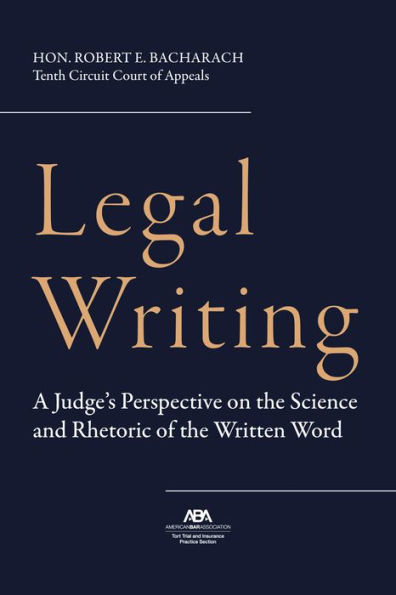"Effective legal writing calls not only for artistry but also for scientific understanding." In this synthesis of his experience on the bench and his own research into the science and art of written communications, Robert E. Bacharach, a federal court judge, shares his insights on ways language can determine different responses -- and how to use this knowledge to craft a powerful and persuasive message.
Judge Bacharach follows a logical progression in crafting effective legal writing, beginning with the importance of an introduction that provides a context for the argument. At this stage, it is important to consider clarity, context, identification of the underlying legal issues, the structure of your argument, and stating the rationale for the optimum outcome.
Subsequent chapters look at specific aspects of effective legal writing, including:
- Organization - the guiding principles of parallelism, logical sequence, and developing the point before responding to the adversarial argument
- Headings - creating a familiar context to make it easier for readers to follow your argument
- Fact sections - the importance of a clearly written summary of legal facts that is readily understandable Sentences and paragraphs - in-depth commentary on structural issues such as varying the length of the sentence structure to key rhetorical devices, all to make the reader follow the flow of the argument
- Diction - how to choose the right word (and why)
- Grammar - the most essential rules to follow for effective legal writing
- Conclusions - how to end strong with a concise reminder of the core points
- Quoting - when--and when not--to use it
- Typography and page layout
Throughout the book, Judge Bacharach illustrates his points with real-world examples from lawyers and judges. As Lisa Blatt of Williams & Connolly states, this is an "easily readable and comprehensive catalogue of do's and don'ts that provides the essential foundations for clear, persuasive legal writing . . . From diction to grammar, and alliterations to aphorisms, this book is mandatory reading for law students and lawyers alike."
"Effective legal writing calls not only for artistry but also for scientific understanding." In this synthesis of his experience on the bench and his own research into the science and art of written communications, Robert E. Bacharach, a federal court judge, shares his insights on ways language can determine different responses -- and how to use this knowledge to craft a powerful and persuasive message.
Judge Bacharach follows a logical progression in crafting effective legal writing, beginning with the importance of an introduction that provides a context for the argument. At this stage, it is important to consider clarity, context, identification of the underlying legal issues, the structure of your argument, and stating the rationale for the optimum outcome.
Subsequent chapters look at specific aspects of effective legal writing, including:
- Organization - the guiding principles of parallelism, logical sequence, and developing the point before responding to the adversarial argument
- Headings - creating a familiar context to make it easier for readers to follow your argument
- Fact sections - the importance of a clearly written summary of legal facts that is readily understandable Sentences and paragraphs - in-depth commentary on structural issues such as varying the length of the sentence structure to key rhetorical devices, all to make the reader follow the flow of the argument
- Diction - how to choose the right word (and why)
- Grammar - the most essential rules to follow for effective legal writing
- Conclusions - how to end strong with a concise reminder of the core points
- Quoting - when--and when not--to use it
- Typography and page layout
Throughout the book, Judge Bacharach illustrates his points with real-world examples from lawyers and judges. As Lisa Blatt of Williams & Connolly states, this is an "easily readable and comprehensive catalogue of do's and don'ts that provides the essential foundations for clear, persuasive legal writing . . . From diction to grammar, and alliterations to aphorisms, this book is mandatory reading for law students and lawyers alike."

Legal Writing: A Judge's Perspective on the Science and Rhetoric of the Written Word
184
Legal Writing: A Judge's Perspective on the Science and Rhetoric of the Written Word
184Related collections and offers

Product Details
| ISBN-13: | 9781641056601 |
|---|---|
| Publisher: | American Bar Association |
| Publication date: | 10/15/2022 |
| Sold by: | Barnes & Noble |
| Format: | eBook |
| Pages: | 184 |
| File size: | 774 KB |
